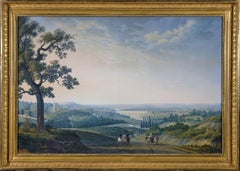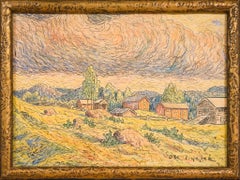Karl Teodor Art
to
2
2
2
2
Watercolor Landscape - Majestic Oak with Country Home in Background
By Karl Teodor
Located in Houston, TX
Rustically charming watercolor on brown paper of an impressive oak tree by German artist Karl Teodor, 1943. Unsigned.
Original vintage one-of-a-kind artwork on paper displayed on a ...
Category
1940s Karl Teodor Art
Materials
Watercolor, Paper
Watercolor Landscape - Waterfall with Mountains in the Background
By Karl Teodor
Located in Houston, TX
Impressionistic style watercolor of a cascading waterfall framed by tree branches heavy with greenery by artist Karl Teodor, 1943. Unsigned.
Original...
Category
1940s Impressionist Karl Teodor Art
Materials
Watercolor, Paper
Related Items
View of the surroundings of Saint-Cloud from Meudon near Paris in France
Located in BELEYMAS, FR
Antoine-Ignace MELLING
(1763 Karlsruhe - 1831 Paris)
View of the surroundings of Saint-Cloud from the terrace of Bellevue in Meudon
Watercolor and gouache
H. 62.5 cm; W. 93.5 cm
Sign...
Category
1810s French School Karl Teodor Art
Materials
Paper, Watercolor
$53,839
H 24.61 in Dm 36.82 in
A Northern Vision in Miniature
Located in Stockholm, SE
This exquisitely detailed drawing by Swedish artist Oscar Lycke captures a rustic settlement nestled in the golden highlands of northern Sweden, most likely depicting the traditional...
Category
1910s Impressionist Karl Teodor Art
Materials
Paper, Crayon, Watercolor, Pencil
Valley View with Pines and Distant Peaks, Sierra Nevada (Possibly Yosemite)
By Carl Oscar Borg
Located in Stockholm, SE
This luminous gouache captures a majestic mountain vista, likely set in California’s Sierra Nevada (possibly Yosemite). Two broad granite peaks with sunlit faces dominate the backgro...
Category
Early 20th Century Impressionist Karl Teodor Art
Materials
Paper, Gouache
$3,469
H 11.03 in W 9.06 in
Untitled: Abstract Figure and Leaves
By Gio Colucci
Located in Berlin, MD
Gio Colucci (Italian 1892-1974) Untitled: Abstract Figure and Leaves. Gouache on paper laid down on matt board. Archival framing under glass. Originally from the Con-Agra Corporat...
Category
Early 20th Century Abstract Karl Teodor Art
Materials
Gouache, Laid Paper
The biggest house in town - Figurative Gouache Painting, Landscape, Architecture
By Piotr Fąfrowicz
Located in Warsaw, PL
PIOTR FĄFROWICZ (born in 1958). He studied art history at the Catholic University of Lublin. He deals with painting and graphic design. Winner of numerous awards for illustrations, i...
Category
21st Century and Contemporary Other Art Style Karl Teodor Art
Materials
Paper, Tempera, Gouache
"Appi" Amaranth Ehrenhalt, Unique Painting, Woman Abstract Expressionism, 2003
By Amaranth Ehrenhalt
Located in New York, NY
Amaranth Ehrenhalt (1928–2021)
Appi 13, 2003
Gouache and watercolor on thick paper
Painting: 20 x 20 cm l 8 x 8 in.
Frame: 33 x 33 cm l 13 x 13 in.
Signed, titled and dated
Amarant...
Category
Early 2000s Abstract Expressionist Karl Teodor Art
Materials
Paper, Watercolor, Gouache
Harbour Dwellings
Located in Norwich, GB
In his early years Colin Kent studied and worked as an architect. He was elected a member of the Royal Institute of Painters in Watercolours in 1971 and then became a full time paint...
Category
21st Century and Contemporary Contemporary Karl Teodor Art
Materials
India Ink, Acrylic, Watercolor, Gouache, Archival Paper
Tenement house - XXI Century, Gouache on paper, Architecture, Landscape
By Piotr Fąfrowicz
Located in Warsaw, PL
PIOTR FĄFROWICZ (born in 1958). He studied art history at the Catholic University of Lublin. He deals with painting and graphic design. Winner of numer...
Category
21st Century and Contemporary Other Art Style Karl Teodor Art
Materials
Paper, Tempera, Gouache
$777
H 11.42 in W 8.27 in
landscape with creek and barn in the distance
Located in Indianapolis, IN
Signed lower right.
Essentially a self-taught artist, Emmitt Thames, born October 28, 1933 in Brookhaven, Mississippi, progressed from a rural depression-era childhood into the rank...
Category
20th Century Karl Teodor Art
Materials
Paper, Watercolor
Watercolor of the Oak Tree by Allen Tucker
By Allen Tucker
Located in Hudson, NY
Landscape watercolor by Allen Tucker of an oak tree. This piece, along with several others, was gifted to Una Brage, a friend of the artist in the 1930s.
More about this artist:
Allen Tucker, was an architect and painter so influenced by Vincent Van Gogh that he was called "Vincent in America". (Gerdts 291) Robert Henri and Maurice Prendergast were also credited as having an influence on Tucker's brushwork and compositions, the latter decisively. However, as his painting evolved, he did not fit into any tidy slot for description and was known as an individualist not easily categorized in American art history.
Tucker was born in Brooklyn in 1866 and graduated from the School of Mines of Columbia University with a degree in architecture and took a job as an architectural draftsman in the architectural firm of McIvaine and Tucker, his fathers business. During that time, he studied painting at the Art Students League with Impressionist John H. Twachtman, but it was not until around 1904, when he was 38, that Tucker became a full-time painter, leaving architecture behind. Many of his early canvases were classically Impressionistic with poplar trees resembling those of Van Gogh and haystacks and corn shocks...
Category
Early 20th Century American Impressionist Karl Teodor Art
Materials
Paper, Watercolor
Cottage by a lake, English School, 19th century
By Wilson Hepple
Located in GB
Wilson Hepple (1854–1937) was an English painter born in Newcastle upon Tyne, Northumberland. He was best known for his sensitive depictions of animals, especially horses, ponies, an...
Category
19th Century Karl Teodor Art
Materials
Watercolor, Archival Paper
"Wild at Heart" (2023) by Mo Myra, Original Watercolor Painting of Horse
Located in Denver, CO
"Wild at Heart" (2023) by Mo Myra is a watercolor painting of a saddled horse in a grassy field. This painting measures 15.5 x 18.5 inches framed and is ready to hang.
Category
2010s Impressionist Karl Teodor Art
Materials
Paper, Watercolor
$1,850
H 15.5 in W 18.5 in
Karl Teodor art for sale on 1stDibs.
Find a wide variety of authentic Karl Teodor art available for sale on 1stDibs. You can also browse by medium to find art by Karl Teodor in paint, paper, watercolor and more. Much of the original work by this artist or collective was created during the 1940s and is mostly associated with the Impressionist style. Not every interior allows for large Karl Teodor art, so small editions measuring 16 inches across are available. Customers who are interested in this artist might also find the work of Diane Baldwin, Frank Forty, and Henri Miloch. Karl Teodor art prices can differ depending upon medium, time period and other attributes. On 1stDibs, the price for these items starts at $375 and tops out at $375, while the average work can sell for $375.

